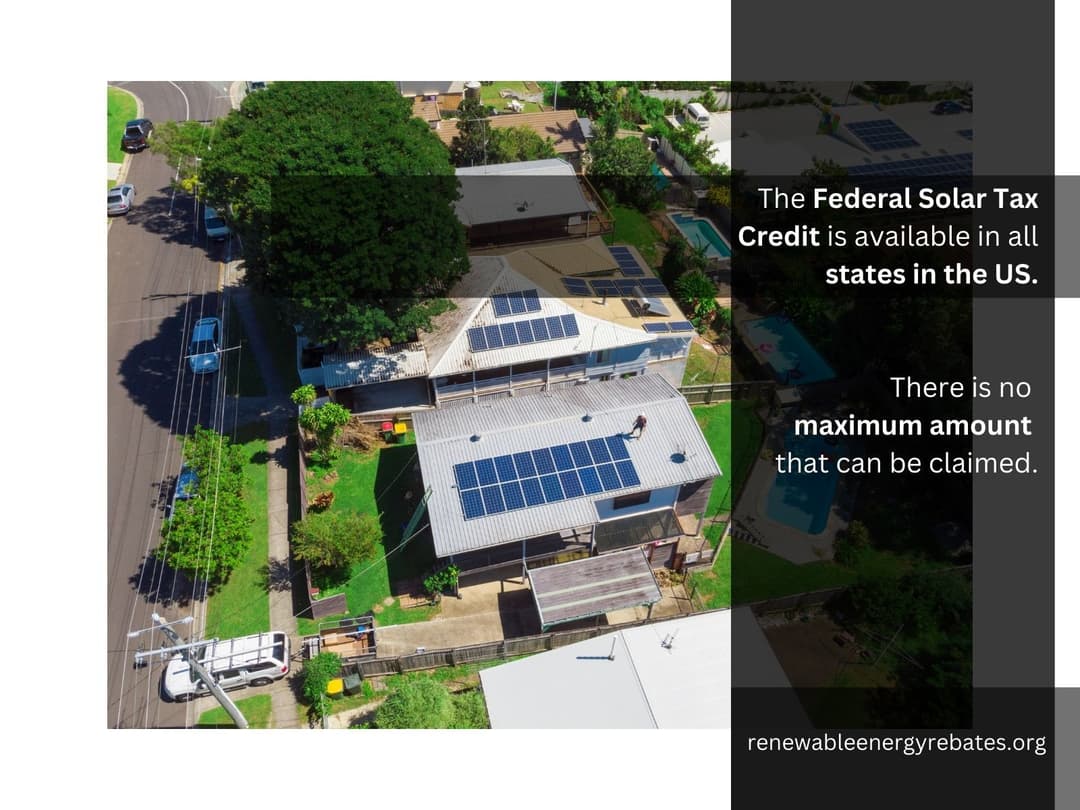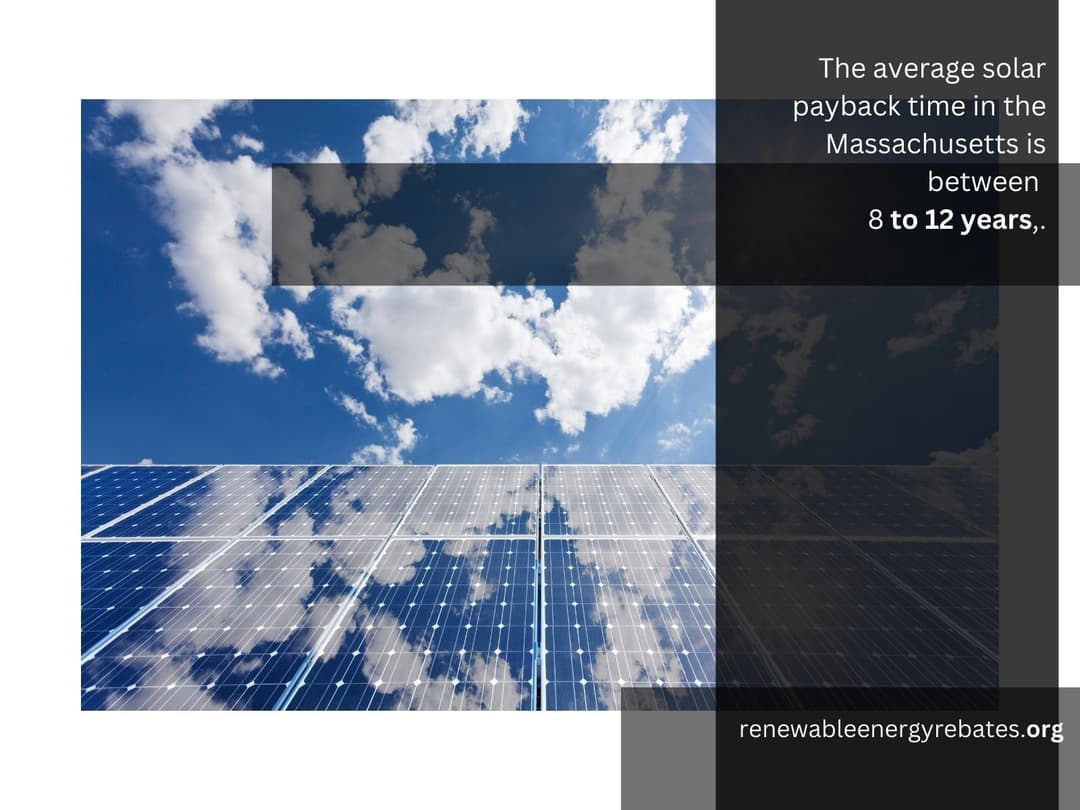Federal Solar Tax Credit in Massachusetts
Learn about the Solar Tax Credit in Massachusetts.
Key Details
- The Federal Solar Investment Tax Credit (ITC) allows Massachusetts taxpayers to claim 30% of the cost of installing a solar energy system as a tax credit.
- Eligible expenses for the tax credit include photovoltaic solar panels, costs of contractor work, wiring, inverters, and mounting devices.
- Homeowners in Massachusetts can claim both a rebate from their utility provider and a state-sponsored incentive along with the ITC.
- Businesses can claim an investment tax credit or production tax credit depending on the size of their PV system and when it was installed.
- To qualify for the federal solar tax credit in Massachusetts, homeowners must have purchased a new solar system between January 1, 2006, and December 31, 2034.
What is the Federal Solar Investment Tax Credit?
The Federal Investment Tax Credit (ITC), also known as the federal solar tax credit, allows Massachusetts taxpayers to claim 30% of the cost of installing a solar energy system as a tax credit.

It remains in effect until 2033, after which it decreases to 26%. There is no limit on the ITC's value, and it is applicable to both residential and business systems.
| State | Cost of installing a 6kw system (Before tax credit) | Federal tax credit value 2023 (30%) |
| Massachusetts | $16,500 | $12,067 |
The ITC was created as part of the Energy Policy Act of 2005. The program was scheduled to terminate at the end of 2007. However, due to its popularity and effectiveness in assisting the United States' transition to a renewable energy economy, Congress has repeatedly postponed its expiration date.
In August 2022, another extension occurred as part of the Inflation Reduction Act, which extended the 30% federal solar tax credit for an extra ten years.
Homeowners in Massachusetts can take advantage of the solar tax credit until 2034.
As of 2023, the ITC's schedule is as follows:
2016 - 2019: The energy tax credit stayed at 30% of the system's cost.
2020 - 2021: Owners of new residential and business solar systems could deduct 26% of the solar system's cost from their federal income taxes.
2022 - 2032: Owners of new home solar systems can deduct 30% of the system's cost from their taxes. Commercial solar systems will also qualify for the 30% ITC until 2025. Subsequently, the US Department of Treasury will decide whether the ITC will be extended for commercial systems.
2023: Owners of new residential solar systems will be able to deduct 26% of the system's installation expenses from their taxes.
2034: Owners of new housing solar systems will be able to deduct 22% of the system's installation expenses from their taxes.
2035: No government credit for residential solar energy systems.
What You Need to Know
How Does the Federal Solar Tax Credit Work?
The solar investment tax credit can be claimed as long as the solar energy equipment is owned by the taxpayer. Homeowners in Massachusetts who don't owe enough in taxes in one year to claim the full credit can "carry over" the unused credit amount into the following years for as long as the credit remains available.
This means that unused credit balances can be carried through to 2034 for residential energy systems as it stands today.
Property owners who enter a lease or power purchase agreement (PPA) with a solar installer do not own the system and, therefore, won't be eligible for the tax credit.
Note: The ITC program accepts taxpayers from any revenue level.
Who Qualifies for the Federal Solar Tax Credit?
Eligibility
If you are unsure whether your solar home installation in Massachusetts qualifies for the ITC, consider the following criteria:
Your PV solar system must be installed between January 1, 2006, and December 31, 2034.
In the United States, your solar PV system has to be installed at your primary or secondary residence.
The electricity produced for an off-site community solar project is credited toward, and should not surpass, the amount of electricity used by your house. A taxpayer may apply for a section 25D tax credit from the IRS if they buy a portion of a community solar installation.
You bought the solar PV system outright or funded it with a loan, so it is yours. You didn't adopt a PPA or a lease.
Your solar PV system is brand-new or in use for the first time. However, you can only claim the credit for the solar equipment's initial installation. For instance, you would not be qualified for a loan if you purchased a home in Massachusetts with a solar panel system already in place.

What’s Covered by the Tax Credit in Massachusetts?
The following expenses are included in the renewable energy tax credit:
- Photovoltaic solar panels or cells, including those used to power an attic fan but not the fan itself.
- Costs of contractor work for site preparation, assembly, or initial installation, as well as developer fees, inspection fees, and permit costs.
- Equipment such as wiring, inverters, and mounting devices
- Energy storage devices that have a 3 kWh or higher capacity grade. This is for devices put in place after December 31, 2022. It is still qualified even if the battery storage is put in during a different tax year than when the solar energy system was put in. The installation date criteria still apply to energy storage devices.
- Sales tax on eligible expenses.
Using Other Incentives in Addition to the Federal Solar Tax Credit
There are several Massachusetts renewable energy rebates to take into account in addition to the ITC. These include rebates, state-sponsored initiatives, and other localized solar energy incentives.
Some of these financial incentives may have an effect on the ITC. However, you can combine them with others to reduce the cost of going solar.
Some of the things you need to know about combining the ITC with other renewable energy incentives in Massachusetts:
Rebates from your utility provider: Generally speaking, income tax returns won't include utility provider rebates. This is a result of a federal statute exemption. Therefore, in this scenario, you would deduct the cost of your system from any utility rebates for installing solar before calculating the tax refund.
State rebates: Generally, these rebates have no impact on your federal tax benefit.
State tax credit: Your federal tax credits won't be reduced if you receive a state tax credit for your solar power system. A typical example is a state property tax credit. Keep in mind, though, that receiving a state tax credit will result in a larger taxable income on your federal returns. This is because you will have less state income tax to offset.
Earnings from renewable energy certificates: Any money you receive from selling renewable energy certificates in Massachusetts will probably be regarded as taxable revenue. This is believed to raise your revenue on a gross basis. However, it won't affect your tax credit.

Federal Solar Tax Credits for Businesses in Massachusetts
There are two available tax credits for enterprises and other entities. They are available to nonprofits, local and tribal governments that purchase solar energy systems:
- The investment tax credit (ITC) is a tax credit that lessens a taxpayer's federal income tax liability by a percentage of the cost of a photovoltaic system installed during the tax year.
- The production tax credit (PTC) is a per-kilowatt-hour (kWh) tax credit for the first ten years of a system's operation for energy generated by solar and other eligible technologies. It lowers federal income tax liability and is adjusted yearly to reflect inflation.
In general, project owners in Massachusetts cannot claim both the ITC and the PTC for the same building. However, depending on IRS guidance, they may be able to claim separate credits for co-located systems, such as solar and storage.
Solar systems placed in service in 2022 or later and beginning construction before 2033 are eligible for a 30% ITC or 2.6 /kWh PTC. They are eligible if they meet the Treasury Department's labor requirements and are less than 1 megawatt (MW) in capacity.
Claiming Federal Solar Tax Credit for An Off-Site Community Solar Program
Off-site solar panels or solar panels that are not directly on the taxpayer's house may still be eligible for the residential federal solar tax credit in some situations, according to the IRS.
Community solar programs, however, can be set up in a variety of methods. Even if you qualify for the tax credit, it might be challenging to claim because of other tax regulations.
One arrangement is the formation of a "special purpose entity." In this case, people of the community organize and finance a company that manages the community solar project.
You are ineligible for the credit if your involvement is restricted to financial contributions to the community solar initiative. This is due to the fact that you do not regularly, consistently, and significantly contribute to the project's administration. You are considered a “passive investor.”
According to IRS regulations, a tax credit related to a passive investment may only be applied to the liability for passive income taxes.
This only pertains to earnings from Massachusett businesses or rental activities in which the individual has no material interest. Because of this, many homeowners won't have passive money to apply toward the credit.
How do I Claim the Federal Solar Tax Credit in Massachusetts?
Required Forms: You will need the following IRS tax forms to claim your solar tax credit.
Fill out Form 1040 as you normally would. At line 5 of Schedule 3 (Form 1040), you should move to Form 5695.
Step 1: Calculate the dollar value of your solar tax credit
- Input the total amount spent on your solar installation on line 1 of Form 5695. This includes the cost of materials and installation fees associated with your new solar system.
Step 2: Transfer any unused tax credit from the previous year
- If you claimed a solar tax credit last year and had a carryover credit, input it on Line 12.
- If this is your first time filing for the ITC, continue to line 13.
- Place lines 6b, 11, and 12 on line 13 together
Step 3: Determine if your tax credit is subject to any restrictions.
- Line 14 – For this line, refer to the spreadsheet included at the top of page 4 of the 5695 instructions.
- Line 1 of the worksheet should contain the total tax liability.
- Line 2 of the worksheet - Additional tax credits and adjustments.
- To determine your credit limit, subtract Line 2 from Line 1 on Line 3 of the worksheet.
Step 4: Estimate the amount, if any, that can be carried forward to the next year's tax return
- Return to Form 5695.
- Insert the number from line 3 of the worksheet into line 14.
- Line 15 – Replace the fewer of lines 13 or 14 (it depends on what your total tax bill is vs. your total tax credits).
- Line 16 – Calculate the difference between lines 15 and 13 to determine whether or not any credit can be carried forward to the next year.
Step 5:Add the amount from Form 5695 to your Form 1040 tax liability
- After calculating the quantity of your solar tax credit, you must transfer it to Form 1040 to complete the procedure.
- Enter the amount from Line 15 of Form 5695 into Line 5 of Schedule 3
- Fill out the remainder of Schedule 3 to determine the amount for Line 8.
- Add the amount from Line 8 of Schedule 3 to Line 20 of Form 1040.
You can now claim your solar tax credit on Form 1040 to reduce your tax liability.